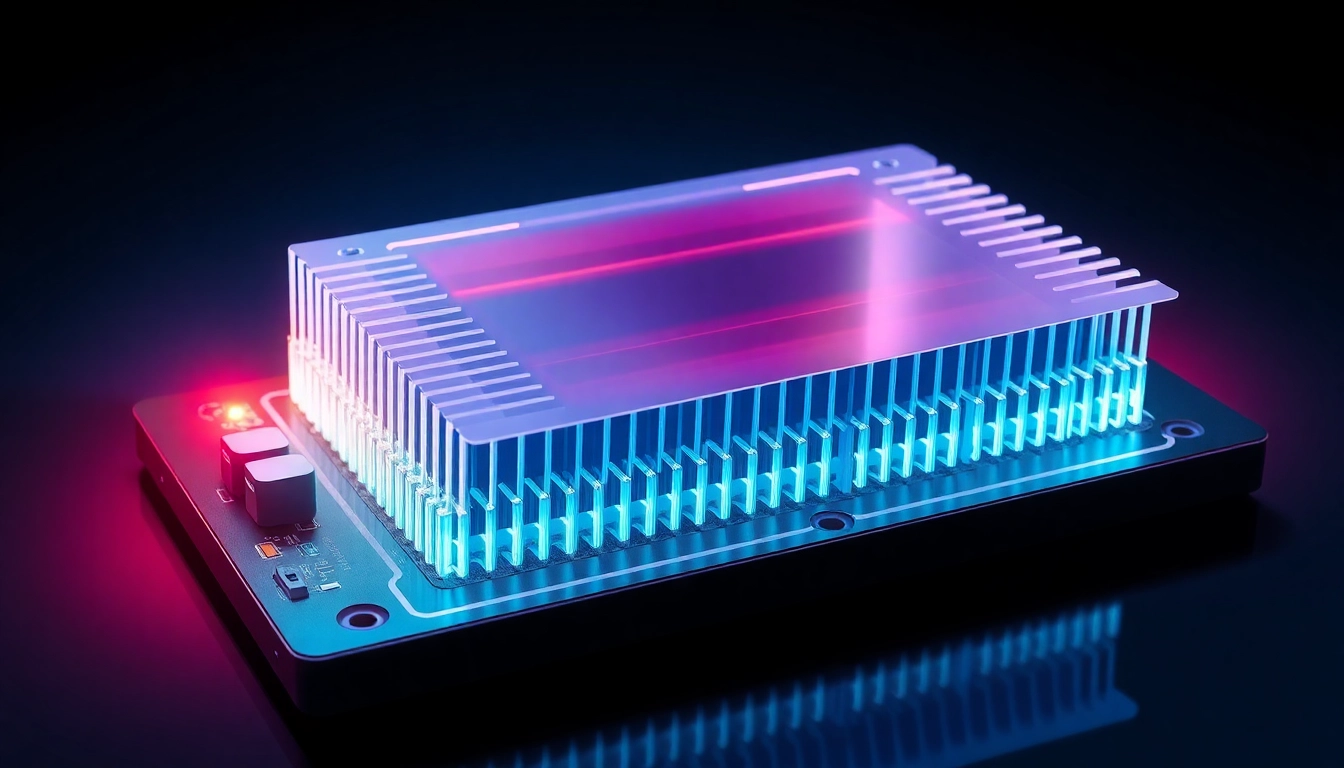Understanding Thermal Management Materials
The rapid evolution of technology and electronic devices necessitates an efficient and effective approach to heat management. Thermal management materials play a vital role in this context, helping to maintain optimal operating temperatures and enhance the performance and longevity of electronic systems. Ensuring efficient heat dissipation is an essential requirement in electronic applications, from consumer gadgets to high-performance computing systems. These materials come in various forms, including adhesives, pastes, pads, and compounds, all of which serve to maximize thermal conductivity and minimize thermal resistance. By utilizing advanced thermal management materials, designers and engineers can ensure reliable and sustainable performance in their devices.
What are Thermal Management Materials?
Thermal management materials are substances specifically formulated to facilitate effective heat extraction from electronic components. These materials are primarily used to improve thermal interface performance between heat-generating components and heat-dissipating solutions such as heat sinks or chassis. The primary characteristics of thermal management materials include high thermal conductivity, low thermal resistance, and durability under various conditions. Some popular types of thermal management materials include:
- Thermal Interface Materials (TIM): These materials bridge the gap between heat sources and heat sinks, enhancing thermal transfer.
- Thermal Adhesives and Tapes: These are used to bond components together while conducting heat away from sensitive areas.
- Phase Change Materials (PCMs): These materials absorb and release thermal energy, stabilizing temperature fluxes during operation.
- Gap Fillers: Flexible materials that conform to surfaces, filling air gaps that might inhibit thermal conductivity.
The Importance of Thermal Management in Electronics
In an era where device miniaturization and high performance are paramount, managing heat effectively becomes increasingly crucial. Excess heat can lead to performance degradation, reduced reliability, and even failure of electronic components. The ability to manage thermal energy directly impacts:
- Device Performance: Improved heat management translates to enhanced device efficiency. Components that operate at optimal temperatures perform better and consume less power.
- Longevity: Effective thermal management can extend the lifespan of electronic devices by preventing overheating, which can lead to premature failure.
- Safety: Overheated devices pose safety risks, making effective heat management essential for protecting both users and the technology itself.
As such, the role of thermal management materials becomes paramount in modern electronics, influencing innovations in design and manufacturing processes.
Types of Thermal Management Materials Available
Numerous types of thermal management materials are available today, each engineered for distinct applications and performances.
1. Thermal Interface Materials (TIM)
Thermal Interface Materials are crucial in ensuring efficient thermal transfer between surfaces. Available in various forms, TIMs include thermal greases, pads, and gels. These materials fill microscopic imperfections between contact surfaces, improving heat flow from one part to another. Applications range from CPUs in computers to LEDs in lighting systems. The selection of an appropriate TIM usually depends on the thermal resistance requirements, ease of application, and reworkability.
2. Phase Change Materials (PCMs)
Phase Change Materials exhibit unique properties that allow them to absorb and release thermal energy during phase transitions. These materials can transition between solid and liquid states, offering a buffer to regulate temperatures effectively. PCMs are particularly beneficial in applications experiencing periodic thermal loads, such as power electronics and automotive systems. By absorbing excess heat during peak loads and releasing it during cooler periods, they help maintain stable operational temperatures.
3. Thermal Conductive Adhesives and Tapes
Thermal adhesives are designed for bonding components while providing thermal conductivity. They are utilized in applications where both adhesion and thermal management are paramount. Examples include attaching sensors to heat sinks or bonding heat spreaders to circuit boards. Thermal tapes offer similar benefits but are generally easier to work with, enabling quick and clean installations.
4. Gap Fillers and Thermal Pads
Gap fillers and thermal pads serve as compliant materials that conform to surfaces, reducing air gaps that can impede heat flow. These materials are particularly effective in packaging applications where components must be tightly packed, and space is limited. Their flexibility allows for superior compaction around irregular surfaces, ensuring maximal thermal contact.
Common Thermal Management Products
Understanding specific products within the realm of thermal management materials is essential. Various solutions address different thermal challenges, making the choice of the right product crucial for maintaining device efficiency.
Overview of Thermal Interface Materials (TIM)
Thermal Interface Materials (TIM) are instrumental in enhancing heat conduction between electronic components and their heat dissipation systems. Traditional thermal compounds, such as silicone-based greases, have evolved to include various innovative materials with enhanced properties. Here’s a closer look at common types of TIM:
- Thermal Greases: These semi-liquid substances contain thermally conductive fillers embedded in a carrier. A common application is in CPUs, ensuring efficient heat transfer to heatsinks.
- Thermal Pads: Solid materials that can be cut to desired sizes and shapes, offering convenience and ease of use. They are particularly effective for applications with larger surface areas.
- Thermal Gels: These offer good conformability and are particularly useful in applications where thermal interface integrity is paramount. They are often used in high-performance computing.
Heat Sink Technologies and Their Efficiency
Heat sinks are passive heat exchangers that dissipate heat generated by electronic components. The effectiveness of a heat sink is influenced by its design and materials, which include aluminum and copper. The primary function of a heat sink is to increase the surface area of a component, allowing for greater heat dissipation rate in combination with airflow. Best practices in heat sink design encompass:
- Material Selection: Different materials exhibit varying levels of thermal conductivity and durability. Highly conductive materials like copper are often preferred for high-performance applications.
- Finned Structures: Fins increase the surface area significantly, promoting better heat transfer. A balance should exist between fin density and airflow obstruction.
- Surface Treatments: Anodizing or applying thermal paints can help improve emissivity, enhancing heat transfer to the ambient environment.
Properly designed heat sink technologies effectively manage heat and maintain optimal operating temperatures, directly influencing the performance and reliability of the electronic systems they serve.
Role of Phase Change Materials in Heat Transfer
Phase Change Materials (PCMs) are crucial for thermal management systems that require efficient energy storage and stabilization of temperatures. These materials operate by absorbing excess heat when melted and releasing it during solidification, thereby moderating thermal fluctuations. PCMs are particularly valuable in applications such as:
- Automotive Engineering: PCMs can help regulate temperatures in electric vehicle batteries, enhancing performance and longevity.
- Data Centers: They are used to manage the heat load in data centers, providing a buffer against sudden peaks in temperatures caused by processing loads.
- Renewable Energy Systems: In solar energy applications, PCMs can store excess heat generated during the day for use during cooler periods, enhancing overall efficiency.
Applications of Thermal Management Materials
Understanding the diverse applications of thermal management materials reveals their significance across various industries. From consumer electronics to automotive engineering, these materials ensure devices operate efficiently and safely.
Consumer Electronics
The consumer electronics industry dramatically benefits from advancements in thermal management technologies. Devices such as smartphones, laptops, and gaming consoles generate significant heat during operation. Proper thermal management materials ensure these devices remain functional and comfortable to use. Key applications include:
- Smartphones: Employing thermal interface materials to conduct heat away from processors enhances performance and reduces overheating risks.
- Laptops and Notebooks: The use of thermal pads and heat-spreading materials allows for effective heat dissipation in compact environments.
- Wearables: In integrated systems like smartwatches, maintaining low temperatures enhances performance and user care.
Automotive Industry Use Cases
In the automotive sector, thermal management materials are fundamental to maintaining efficient operation within vehicles. Particularly in electric vehicles (EVs) and hybrid systems, managing battery thermal efficiency is crucial for performance and safety. Applications in this field include:
- Battery Thermal Management: ESs utilize phase change materials to moderate temperatures during charging cycles.
- Power Electronics: TIMs and adhesives are utilized to dissipate heat effectively from power modules, ensuring long-term reliability.
- Engine Cooling Systems: Advanced thermal materials contribute to the efficiency of engine cooling systems, braving physical locations where heat control is critical.
Industrial and Medical Applications
Thermal management materials find usage in various industrial applications ranging from manufacturing processes to critical medical devices. In these contexts, the demands placed upon thermal materials can be stringent as they must withstand harsh environments. Notable applications include:
- Industrial Equipment: Specialized thermal adhesives and gap fillers ensure that heavy machinery operates efficiently and in safety compliance.
- Medical Devices: Precise temperature control in devices like diagnostic instruments and handheld devices benefits from the use of advanced thermal management materials.
- Robotics: Robots operating in industrial environments rely on effective thermal interfaces to maintain performance during extended applications.
Choosing the Right Thermal Management Solutions
Selecting appropriate thermal management solutions involves careful consideration of various factors to ensure success in application. Applying the wrong material or product can lead to inadequate thermal performance, which can trigger device failure. Therefore, a systematic approach is critical.
Factors to Consider When Selecting Materials
When evaluating thermal management materials, the following factors should guide the selection process:
- Thermal Conductivity: This is the most critical parameter, dictating how well a material can transfer heat. Higher conductivity is preferred for thermal interface materials.
- Viscosity and Application Method: Some materials are easier to apply than others. For practical applications, consider materials that fit the manufacturing process in use.
- Thermal Stability: The material must maintain its properties over the expected operating temperature range without degrading.
- Cost and Availability: Assess the cost-effectiveness of the material in relation to performance benefits and application requirements.
Performance Metrics and Testing Standards
Establishing quality control and performance metrics is vital for thermal management materials and their applications. Various standards (like ASTM and ISO) provide guidelines for testing the thermal performance of materials. Common performance metrics include:
- Thermal Resistance (R-value): This is a measurement indicating a material’s resistance to heat flow; lower values indicate better conductivity.
- Thermal Conductivity (W/m·K): A measure of a material’s ability to conduct heat. This metric becomes critical in selecting TIMs and compounds.
- Durability Tests: Extended testing under varying environmental conditions ensures materials meet longevity and reliability expectations.
Common Challenges in Thermal Management
The implementation of thermal management solutions can be fraught with challenges. Identifying and acting upon these challenges fosters better engineering decisions and outcomes.
- Air Gaps: Even the tiniest air gap between heat-generating components and heat sinks can hinder thermal conduction. Robust TIMs can minimize these precautions.
- Material Aging: Over time, thermal compounds may degrade, leading to increased thermal resistance. Regular monitoring and potentially periodic maintenance or replacement can mitigate this issue.
- Compatibility: Choosing materials that interact safely with surrounding components and do not induce corrosion is crucial.
Future Trends in Thermal Management Materials
The field of thermal management materials is continuously evolving. Technological advancements, coupled with increasing demand for higher performance and improved energy efficiency in electronics, propel innovations that correspond to industry needs.
Innovations and Emerging Technologies
As electronic devices become increasingly powerful and compact, innovative thermal management materials are developed to address specific challenges. Emerging technologies swerve around the following trends:
- Nanomaterials: The integration of nanotechnology into thermal management materials offers superior thermal conductivity and lightweight options.
- Smart Materials: Thermoresponsive materials adapt to changing thermal conditions, reflecting the real-time requirements of a system.
- Composites: Combining different materials into a single product can yield excellent thermal performance with added mechanical properties.
Sustainability in Thermal Management
The growing emphasis on sustainability and eco-friendly practices permeates thermal management materials. Manufacturers are increasingly turning toward renewable or recyclable materials in their formulation processes. Furthermore, energy efficiencies derived from effective thermal management practices contribute to the overall sustainability of electronic products.
The Impact of IoT on Thermal Management Solutions
The Internet of Things (IoT) introduces new challenges and opportunities for the thermal management sector. With an increase in smart devices, ensuring proper thermal management becomes even more critical. IoT devices often operate in diverse environmental conditions, necessitating adaptive thermal management solutions that ensure they perform efficiently without failure.
As IoT technologies advance, the demand for tailored thermal management materials that can adapt to various contexts will shape future developments in the industry.



